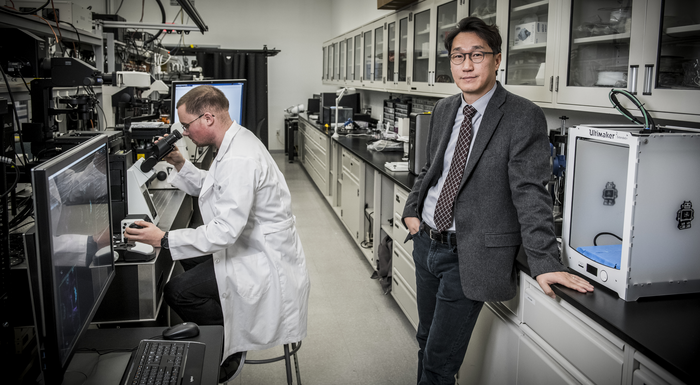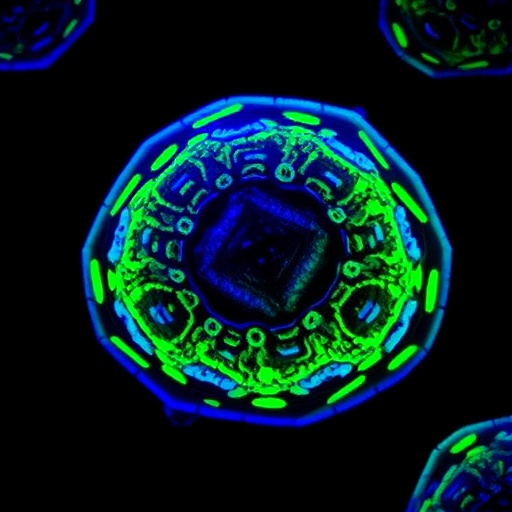DALLAS (SMU) – Collaborative research between SMU nanorobotics authority MinJun Kim’s Biological Actuation, Sensing, and Transport (BAST) Lab and international research and engineering company ARA has demonstrated for the first time that certain chemical coatings, applied to micro/nanoparticles, can alter their swimming propulsion within biological fluids.

Credit: SMU (Southern Methodist University)
DALLAS (SMU) – Collaborative research between SMU nanorobotics authority MinJun Kim’s Biological Actuation, Sensing, and Transport (BAST) Lab and international research and engineering company ARA has demonstrated for the first time that certain chemical coatings, applied to micro/nanoparticles, can alter their swimming propulsion within biological fluids.
The joint research, “Spontaneous symmetry breaking propulsion of chemically coated magnetic microparticles,” has been published in Scientific Reports.
Designing specialized surface coatings to generate specific propulsion properties will provide new approaches to drug delivery strategies, the study concludes. Being able to navigate microparticles quickly will support drug deployment when delivery speed is critical for patient recovery. In addition, being able to precisely navigate these “swimming” microparticles will allow them to travel through complex fluids and tissue environments to targeted locations in the human body.
“Thanks to SMU’s partnership, we will continue to push the boundaries of microrobotics research and look forward to sharing our ongoing work with the scientific community,” said Louis William Rogowski, lead microrobotics investigator at ARA. “We are honored to have our joint research published in Scientific Reports.”
Rogowski, Kim and their team members were able to demonstrate that changing the surface chemistry of microparticles can dynamically change propulsion behavior.
“We are excited to see the feasibility of chemically coated magnetic microparticles for precise navigation in bodily fluidic environments,” said Kim, the Robert C. Womack Chair in SMU’s Lyle School of Engineering and principal investigator of the BAST Lab. “We will continue to work together to develop a new type of microrobotics for targeted drug delivery systems.”
For this study, biotin, Biotin-PEG3-amine and biotin chitosan were chemically applied to the surface of microparticles. Coated microparticles were then suspended in mucus synthesized from porcine stomach mucins (glycoproteins found in mucus) and navigated with rotating magnetic fields using a spontaneous symmetry breaking propulsion mechanism. The surface coatings altered the propulsion behavior of microparticles, depending on both magnetic field properties and localized mucus properties.
Next steps, say the researchers, include coating microparticles with an actual pharmaceutical compound and measuring uptake within live environments using “swarms” of microparticles, or examining cellular membrane interactions. Designing specialized surface coatings to generate specific propulsion properties will also provide new approaches to drug delivery strategies. The authors hope the study will increase interest into microparticle-based propulsion mechanisms and help provide novel innovations to targeted drug delivery applications.
###
About ARA
Applied Research Associates, Inc. (ARA) was founded in 1979, in Albuquerque, New Mexico, to offer science and engineering research to solve problems of national importance. ARA delivers leading-edge products and solutions for national defense, energy, homeland security, aerospace, healthcare, transportation, and manufacturing. With over 1,500 employee-owners at locations in the U.S. and Canada, ARA offers a broad range of technical expertise in defense technologies, civil engineering, computer software and simulation, systems analysis, biomedical engineering, environmental technologies, and blast testing and measurement.
About SMU
SMU is the nationally ranked global research university in the dynamic city of Dallas. SMU’s alumni, faculty and more than 12,000 students in eight degree-granting schools demonstrate an entrepreneurial spirit as they lead change in their professions, communities and the world.
About the Lyle School of Engineering
SMU’s Lyle School of Engineering, founded in 1925, is one of the oldest engineering schools in the Southwest. The school offers eight undergraduate and 29 graduate programs, including master’s and doctoral degrees, through the departments of Civil and Environmental Engineering; Computer Science; Electrical and Computer Engineering; Engineering Management, Information and Systems; and Mechanical Engineering.
Journal
Scientific Reports
DOI
10.1038/s41598-022-21725-z
Method of Research
Observational study
Subject of Research
People
Article Title
Spontaneous symmetry breaking propulsion of chemically coated magnetic microparticles
Article Publication Date
21-Oct-2022




